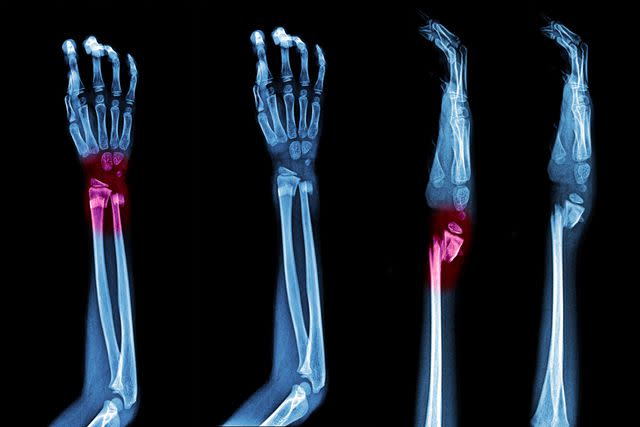What Is a Comminuted Fracture?
A Bone That's Broken Into 3 or More Pieces
A comminuted fracture is a type of broken bone in which the bone breaks into three or more pieces. It’s usually caused by an intense impact, like a car accident or a severe fall. Comminuted fractures usually occur in the long bones of the arms and legs.
Oftentimes, a comminuted fracture needs to be treated with surgery. During surgery, a healthcare provider will place screws and rods to hold the pieces of the bone in position while they heal. Sometimes, this hardware is left in your body permanently. Depending on the location of the fracture, you may need to wear a cast for several months. You may also need physical therapy.
Continue reading to learn more about comminuted fractures, including how you fix a comminuted fracture, symptoms of comminuted fractures, and prognosis.

Sitichok Kanlapasut / Getty Images
Types of Comminuted Fracture
A comminuted fracture is a break in which the bone is broken into at least three pieces. With this type of fracture the bone is completely broken, not just cracked. If the bone is broken into four of more pieces, the break is called a highly comminuted fracture.
Comminuted Fracture Symptoms
The symptoms of a comminuted fracture are the same as those of other types of broken bones. They may be more intense, since the bone is broken in multiple places. This means there may also be more soft tissue injury than typically occurs with a simple fracture. The symptoms of broken bones include:
Lots of pain
Swelling and bruising
Deformity, which means the bone looks out of place or is at a strange angle
Tingling or numbness
Problems moving the limb
Causes
A comminuted fracture is caused by a great deal of force. Most often, this type of break occurs after a car accident or a significant fall. They can also result from sports injuries, like a ski accident or football tackle.
Diagnosis
A comminuted fracture must be diagnosed by X-ray. With these imaging techniques, the healthcare provider can see where your bone has broken and how many pieces it has split into.
You should seek immediate medical care if you believe you have a fracture. Healthcare providers will not only diagnose any broken bones but also look for other injuries caused during your accident.
Treatment
Typically, broken bones can be treated with casts, braces, or a boot to keep the bone immobilized while it heals. Since a comminuted fracture is more severe, it often needs other treatments, including surgery.
Sometimes, the bone can be set using a technique called closed reduction. Instead of surgery, the healthcare provider manually moves the bone into place using their hands on the outside of your skin. If that’s not possible your healthcare provider may recommend surgery.
Types of Surgery to Treat Comminuted Fractures
In many cases, comminuted fractures require surgery. Surgery allows your healthcare provider to get all the pieces of the bone into the correct position to heal in a strong, stable formation.
The two types of surgery commonly used to treat comminuted fractures are:
External fixation: This surgery uses rods and screws visible outside the body to stabilize the bone. This external frame is placed during surgery and later removed.
Open reduction internal fixation (ORIF): During this surgery, the bone is stabilized with metal plates, screws, rods, and/or wires placed inside your body. Sometimes these are permanent, but in other cases, they are removed during a later surgery.
These surgeries are often done by an orthopedic surgeon, a doctor who operates on bones.
Casting
After surgery, you’ll often need a cast. Casts keep your bone from moving, allowing it time to heal.
Typically, patients with broken bones wear casts for six to eight weeks. However, since comminuted fractures are more severe, you might need to wear a cast for longer. Some patients need a cast for several months. Sometimes, if you have an external fixation, you’ll need to continue to wear a cast after the pins and rods are removed. That gives your bone more time to stabilize.
Talk with your healthcare provider about how long you’ll wear a cast. Ask them if you must avoid certain activities—like contact sports—even after the cast comes off.
Physical Therapy
Your healthcare provider might recommend physical therapy to help treat your fracture. Often this happens when the cast is removed to help you rebuild strength and range of motion.
Prognosis
If you follow your healthcare provider’s orders and treatment plan, the prognosis for people with comminuted fractures is good. Although these fractures are severe, they’re treatable. Most people don’t have lingering pain after the initial injury and can eventually return to regular activities.
Coping
Healing a comminuted fracture can take months. During that time, it’s helpful to focus on tasks you can accomplish. Try new hobbies that don’t have a risk of physical injury. Or, take time to decorate your cast. If you have any problems with your cast or ongoing pain, be sure to talk to your healthcare provider.
Summary
A comminuted fracture is a severe break in which the bone splits into at least three pieces. Comminuted fractures are most likely to occur in long bones like those in the arms and legs. However, they can also happen in other places, including the ribs.
Recovery from a comminuted fracture can take months and often involves surgery, casting and physical therapy. Talk to your healthcare provider about what to expect as you heal from your broken bone.

